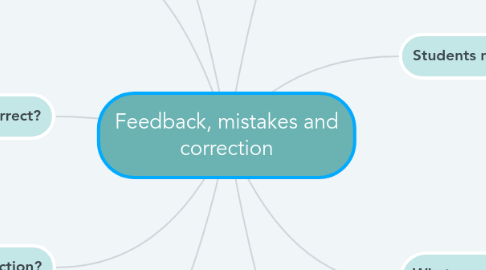Feedback, mistakes and correction
by Elena T.

1. Giving supportive feedback
1.1. This is the typical IRF (Initiation-Response-Feedback) secuence appears to include, at the end, the teacher’s evaluation of what the student has said. Such summative feedback (where the comment is about something that has happened) is in contrast to formative feedback, where teachers hope that what they say will help their students to do it better in the future. The teacher will explain what explain what it was the student did that was Good. It should be truthful (not just ‘empty praise’) and it should encourage the students to think for themselves. Phrases like Good and Very Good don’t seem to be adequate for this.
2. Students make mistakes
2.1. Categories of mistakes
2.1.1. Slips: That is, mistakes wich the students can correct themselves once the mistake has been pointed ot to them
2.1.2. Errors: Mistakes which they can’t correct themselves- and which, therefore, need explanation)
2.1.3. Attempts: That is when a student tries to say something but does not yet know the correct way of saying it
2.2. Two distinct sources for the errors:
2.3. L1 interference
2.4. Developmental errors.
3. Correction decisions
3.1. We have to think about who is the best person to make that correction: themselves, the teacher, or maybe even the student’s peers (his or her classmathes)
4. What to correct?
4.1. Grammar mistakes (He go to work every day)
4.2. Pronunciation mistakes (I don’t like eschool)
4.3. Vocabulary mistakes (I did an error)
4.4. Register mistakes (Give me the book, teacher)
5. When to correct?
5.1. Many teachers make a distinction between accuracy and fluency. In accurancy work (where the students are studying specific gramar or vocabulary, for example) the focus i son language forms. Fluency work is taken to mean the stages in a lesson where the students are focussing more on the content of what they are saying, and where they are doing their best to communicate as effectively as possible.
6. What corrects and who should be corrected?
6.1. Sensitivy is required at all stages of correction, however. Before we start, we have to judge whether a student is in the right frame of mind to be corrected (eighter because of their personality or because of what they are saying), and then we have to adapt our approach yo correction, depending on what we judge to be appropriate for that particular student at that particular time.
7. What to do about correction?
7.1. Of all the elements that make up classroom practice, correction is perhaps the one that most merits teacher rflection and action research. And because it is so personal, we may well want to ask the students what they feel about it and what they would like us to do, and to use this infmoration to inform our teaching behaviour
8. Correcting spoken English
8.1. Online (on the spot) correction: Is generally more suited to speaking activities where the focus is on acurracy. Firts we indicate that something isn’t quite right. This may be enough to make the student ‘think again’ and self-correct)
8.2. Offline (after-the-event) correction: One of the problems of giving feedback after the event is that is easy to forget what students have said. Most teachers, therefore, write down points they want to refer to later. Some teachers make notes and write down what they hear, others go further and use charts or other forms of categorisation to help them to this.
9. Giving feedback for writing
9.1. We have to decide whether to give feedback on the content of what our students have written or whether it is the form of what they have written (how correct their grammar and spelling is) that should occupy our interest. In the end, it may depend on whether we are giving feedback on a finished ‘product’.
9.2. Giving feedback in process writing



